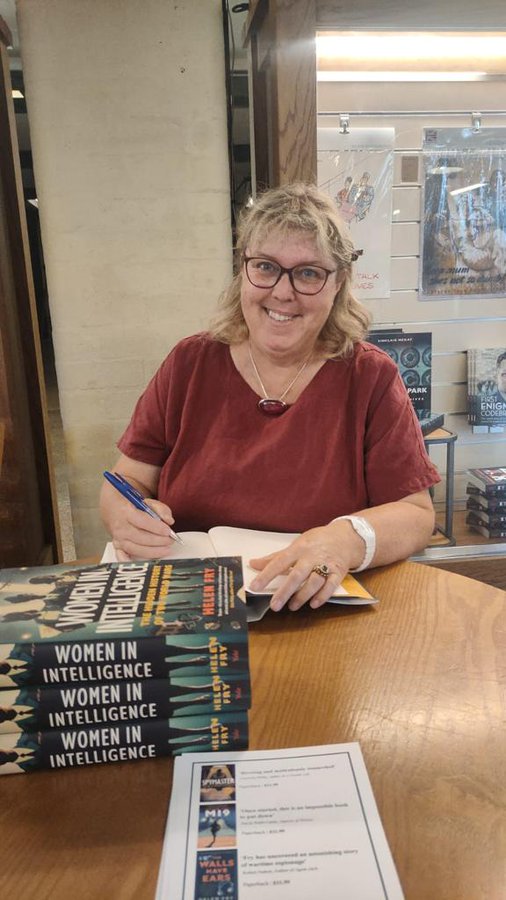
Mrs Olive Myler working for MI6. Credit: Helen Fry
In the tapestry of North Devon’s wartime history, Mrs Olive Myler emerges as an extraordinary figure - a woman of mystery and distinction as a female voluntary interceptor (VI) in the region during World War Two. It was Olive Myler's job as a radio ham to spy on German communications.
What sets her apart further is the recognition she earned, being the only one among three women VIs to receive the prestigious British Empire Medal (BEM) for her invaluable contributions.
Helen Fry, a local historian, has delved into Olive Myler's wartime career which, through her recent book, Women in Intelligence: The Hidden History of Two World Wars, she shared her interesting choice of work.
Mrs Myler’s journey into the world of intelligence was already underway by the 1930s. Before the outbreak of war, she served as a spy in Vienna under the guidance of Thomas Joseph Kendrick, a senior MI6 spymaster. Fleeing the German invasion of Austria in 1938, she sought refuge in Knowle, near Braunton, where her covert work continued.
Operating from a modest cottage in Knowle, Mrs Myler took on the role of a voluntary interceptor, distinguishing herself as the sole woman among 1,700 counterparts. The secrecy surrounding her mission, marked by a unique call sign, added to her mystique.
In fact, by 1941, the community’s suspicions led to an investigation by MI5 and local police, resulting in Mrs Myler’s arrest. However, the misunderstanding was quickly cleared and she was released.
Across the country, approximately 1,700 people worked as voluntary interceptors during the war, and only three of them were women. The world of radio hams was very much a male one, making the presence of female operators a rarity and, consequently, a source of curiosity. Nevertheless, the small number of female radio hams, including Mrs Myler, had the respect of their male colleagues.
Each interceptor was issued with a specific frequency for listening in to German signals. They were also given a band to record any sound they heard, whether it was a tone, Morse code, or just a hum.
Mrs Myler’s role as a voluntary interceptor involved listening in for German communications, particularly messages transmitted within the UK from German spies.
In the 1970s, revelations about Bletchley Park, the main centre for British codebreakers during World War II, highlighted the significant contributions of individuals like Mrs. Myler. Some voluntary interceptor messages were passed to Bletchley Park for decoding, underscoring the collaborative efforts across various intelligence hubs.
To carry out her mission effectively, Mrs Myler erected a 50-foot mast in the garden of her home. Her role extended beyond passive listening, as she actively scanned for unusual transmissions from anywhere in the UK. The intercepted messages, including Morse code, were sent to a central location headquarters known as 'Box 25'.
The scope of Mrs Myler’s interceptions went beyond routine communications; she intercepted messages detailing the loading of German U-boats, a crucial intelligence task during wartime. It is likely that many interceptors in North Devon played pivotal roles in such endeavours.
Mrs Myler’s radio ham activities endeared her to the locals, dispelling initial scepticism. Despite the challenges of being an anomaly in her role, she was well-liked, remembered for her sense of fun in the community.
The culmination of Mrs Myler’s remarkable service was marked by the post-war recognition of her efforts. She is the only woman among the three female VIs to be awarded the British Empire Medal (BEM), an honour that underscores the significance of her contributions to wartime intelligence.
Her legacy lives on in Ilfracombe’s Score Cemetery, where she found her final resting place. Mrs Myler’s story, unearthed by local historian Helen, reflects a commitment to acknowledging the often-overlooked roles of women during World War II.
Helen, a historian with over 25 years of experience, grew up in North Devon but now lives in London. Her connection to Mrs Myler’s story is somewhat personal, as her father-in-law remembers Mrs Myler from his youth.
Helen made it her mission as a researcher to uncover as much as possible about this mysterious woman. The difficulty of reconstructing Mrs Myler’s life only fuelled Helen’s determination to tell her story. Reflecting on the endeavour, Helen said: “Even if we can’t know everything she did, it’s nice that she did get a mention.”
In addition to her research on Mrs Myler, Helen has dedicated her expertise to a broader exploration of women’s roles in intelligence. Her latest book, Women in Intelligence, offers a captivating journey into the lives of these often-overlooked heroines.
Available at local Waterstones and Amazon, the book sheds light on the remarkable contributions of women in intelligence during times of conflict.

Helen's book is available to purchase via Waterstone's here: https://www.waterstones.com/book/women-in-intelligence/helen-fry/9780300260779
Subscribe or register today to discover more from DonegalLive.ie
Buy the e-paper of the Donegal Democrat, Donegal People's Press, Donegal Post and Inish Times here for instant access to Donegal's premier news titles.
Keep up with the latest news from Donegal with our daily newsletter featuring the most important stories of the day delivered to your inbox every evening at 5pm.